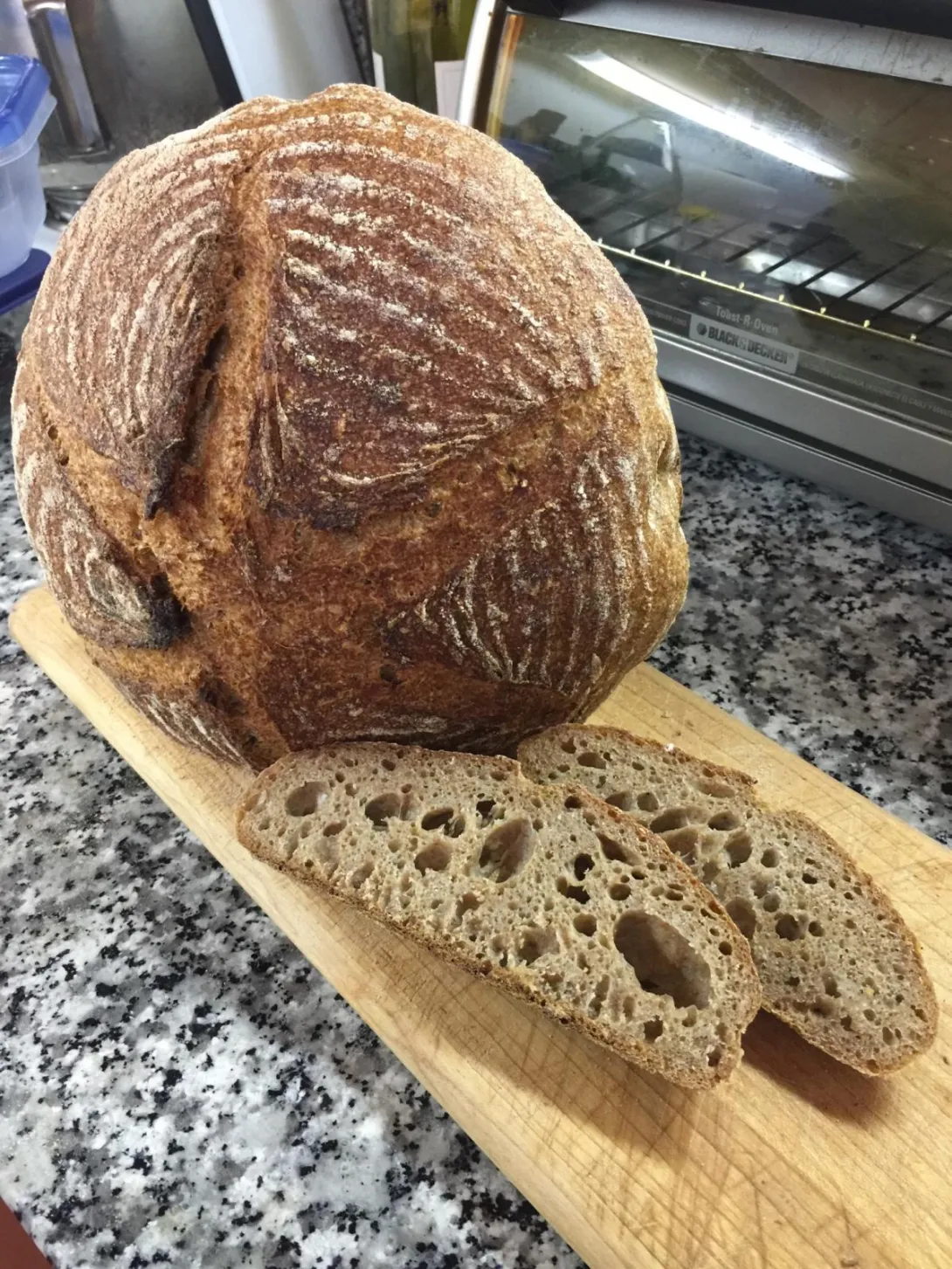
This is my latest loaf - Della Fattoria's pane integrale substituting cracked rye for cracked wheat. This is the fifth time I've made this bread and it is by far the best. I had posted before about how it had come out gummy. I seem to have solved this by lowering the temperature to 425° with convection (using a combo cooker). In many ways I'm very pleased with this - it is really delicious (the cracked rye makes a huge difference) - but I wonder what I could still do better. The crumb is much more open than before, perhaps too much so. I did an overnight bulk ferment in the fridge. When I took it out the dough seemed very slack, so I gave it another stretch and fold before shaping it. I had no trouble shaping it but when I took it out of the banneton it immediately started to spread. The oven spring was OK but I would have preferred it to not spread so much before going into the combo cooker. After about 45 mins proofing a finger test seemed to suggest it should go in the oven but I had to wait about another 30 mins before I could get it in (too much going on around the stove). The formula as I did it was WW 60%, bread flour 20%, pumpernickel flour 10%, cracked rye 10%, water 84%, stiff levain 14%, starter 2%, and honey 7%. Any constructive criticism would be welcome. Many thanks, Mark
This loaf looks way better than that earlier sad, gummy one (been there, done that). You're learning with each bake - your eyes, your hands, your palate, all are gaining experience that enable you to make meaningful choices as you proceed. It's powerful - congrats!
As for suggestions to improve, the crumb looks open, but a bit inconsistently so... and your comment about spreading (sorta comes with the territory with rye), makes me agree with your assessment that an extra stretch and fold was in order. I'm thinking even one more would have evened out the holes and strengthened your shaped loaf.
Keep going! I'm betting no one will turn it down when it looks this good. You'll be beating them off with a stick as it gets that much better.
Cathy
I allow my final rise in a parchment lined bowl the diameter of which is less than the diameter of my Dutch oven. I then transfer my dough into the DO using the parchment paper as a sling. Yes, the paper ends up in the DO with the dough in it. I bake similar slack dough loaves covered always starting at 500 for 30 minutes, then uncovering and lowering the oven temperature to 450 for the final duration (usually 25-30 minutes) until the dough's temperature, measured by thermometer poked in through the bottom crust, measures about 200 F.
I use an 80% hydration starter which helps a fair bit for the dough to keep its shape.
I also put my dough after kneading for 12-18 hours in the fridge to bulk ferment * 18 hours when I have a lot to do * , than I take it out of the fridge , shape it into a boule * a doodle when your dough is cold * put it in the floured banneton, add some flour on top of the boule.
I put the banneton on a kitchen towel, put another clean kitchen towel over the top , fold the bottom kitchen towel sides over the top kitchen towel and put that little parcel in a plastic bag and in the fridge for the next 12 hours.
Preheat my Oven to 250C, get the dough from the fridge, tip it onto parchment paper, score , put it WITH the parchment paper in the Dutch oven , bake for 30 minutes at 250 C , than take the lid of and bake at 200C for another 20 minutes.
Great rise, fantastic crust and nice crumb * I must say so that I do not like these big holes, one can not eat holes ;) *
Baking in the Dutch Oven for that lenght of time I do not need the temperature to see if the bread is done, it is always done :)
Yes, Cathy, I do think it needed more structure so another set of stretch and folds probably would have helped. I think I'll throw in another set before retarding the bulk fermentation in the fridge. Rich and Petra, I'm interested to see that you are starting the bake at a significantly higher temperature - 500F/260C and 482F/250C. But then your approaches diverge - Rich, you keep the temperature fairly high while you, Petra, lower it significantly. I've lowered my bake temperature to 425F with convection as at higher temperatures I found the crust was drying out while the crumb remained still too moist. I am using parchment paper. I find it is too easy to drop the boule into the DO crooked and parchment paper solves that. I don't take the parchment paper out until the loaf is nearly cooked. My recipe for this bread calls for a starter at 56% hydration. Are you suggesting Petra that a wetter starter would help the dough keep its shape, or were you comparing to 100% hydration? And do you retard both the proofing and the bulk fermentation because it fits your schedule better or because it helps to better structure the loaf? I take it you put the loaf directly in the oven after removing it from the fridge. Does that help keep the shape? Again, many thanks for the comments. : )